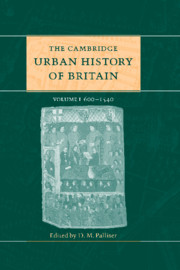Book contents
- Frontmatter
- Part I Introductory
- Part II The early middle ages 600–1300
- Part III The later middle ages 1300–1540
- 12 General survey 1300–1540
- 13 Government, power and authority 1300–1540
- 14 The economy of British towns 1300–1540
- 15 Urban culture and the Church 1300–1540
- 16 The built environment 1300–1540
- 17 London 1300–1540
- 18 The greater towns 1300–1540
- 19 Port towns
- 20 Small towns 1270–1540
- Part IV Regional surveys
- Part V Conclusion
- Appendix: Ranking lists of English medieval towns
- Select bibliography
- Index
- References
15 - Urban culture and the Church 1300–1540
from Part III - The later middle ages 1300–1540
Published online by Cambridge University Press: 28 March 2008
- Frontmatter
- Part I Introductory
- Part II The early middle ages 600–1300
- Part III The later middle ages 1300–1540
- 12 General survey 1300–1540
- 13 Government, power and authority 1300–1540
- 14 The economy of British towns 1300–1540
- 15 Urban culture and the Church 1300–1540
- 16 The built environment 1300–1540
- 17 London 1300–1540
- 18 The greater towns 1300–1540
- 19 Port towns
- 20 Small towns 1270–1540
- Part IV Regional surveys
- Part V Conclusion
- Appendix: Ranking lists of English medieval towns
- Select bibliography
- Index
- References
Summary
introduction: points of perspective
In 1314 the spire of St Paul's Cathedral in London was damaged by a lightning bolt. The repairs accomplished, a man clambered carefully to the scaffold's summit and replaced the great cross, charged with its precious contents of relics which included a fragment of the cross of Christ. From up here, one commanded a panorama of the city. The square mile of the walled area, and the straggling suburbs to east and west and to the south of the River Thames, were all displayed to view. The urban vista was punctuated by the towers of a hundred parish churches and a score of convents, whose smaller scale expressed, from the perspective of the cross of Paul's, their subordinate and ancillary status. Order was additionally revealed in a network of streets still marked by a grid plan imposed four centuries before by an Anglo-Saxon king. From this vantage point the city appeared entire, comprehensible and available for possession. When, in the sixteenth century, the first urban mapmakers were encouraged by municipal councils to publish such another panoptic vision of the city, they made the same climb in order to construct from steeple-tops the impression, before the possibility of human flight, of the bird's-eye, all-encompassing view. Bishop, monarch and magistrate each conceived of the city as a visible entity, conveniently subject to his direction and control.
- Type
- Chapter
- Information
- The Cambridge Urban History of Britain , pp. 335 - 370Publisher: Cambridge University PressPrint publication year: 2000
References
- 4
- Cited by



